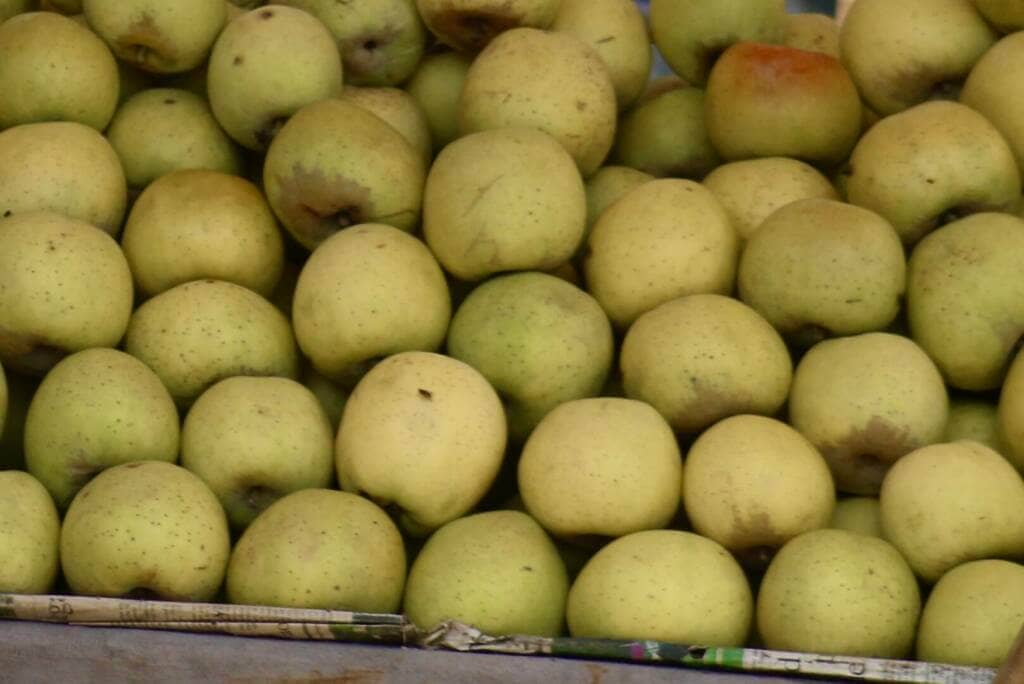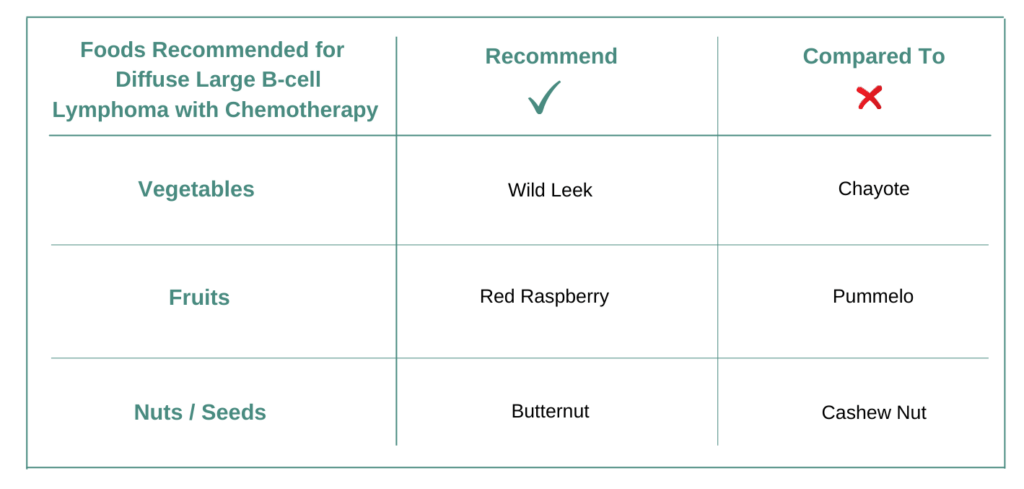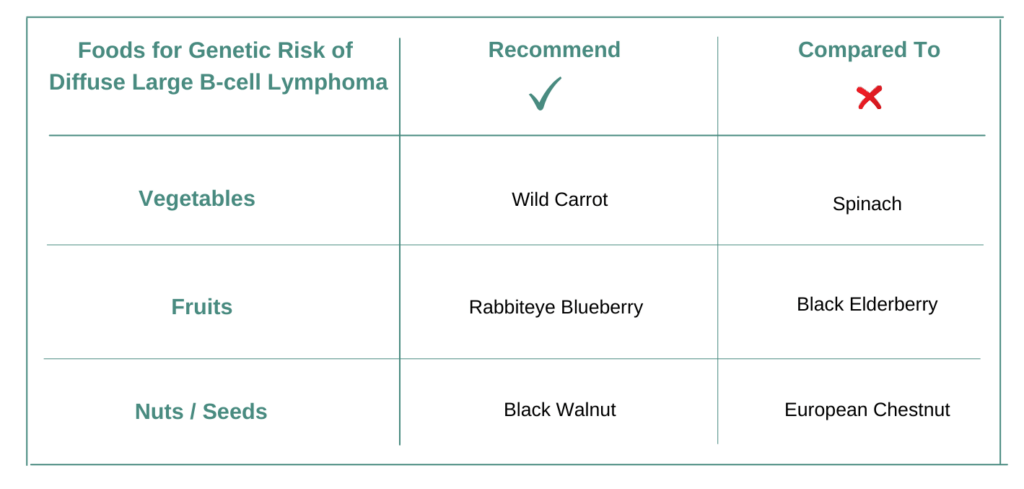Introduction
Foods for Diffuse Large B-cell Lymphoma should be personalized for each individual and also must adapt when cancer treatment or tumor genetic change. The personalization and adaptation must consider all the active ingredients or bioactives contained in different foods with respect to cancer tissue biology, genetics, treatments, lifestyle conditions and diet preferences. Hence while nutrition is one of the very important decisions for a cancer patient and individual at risk of cancer to make – how to choose foods to eat is not an easy task.
Diffuse large B-cell lymphoma (DLBCL) is the most common and most aggressive subtype of non-Hodgkin’s lymphoma. DLBCLs have a rapid growth rate and present as masses infiltrating tissues or obstructing organs. This is a heterogeneous b-cell lymphoma with subtypes based on cell of origin and or genomics. The key subtypes with different underlying molecular and genomic characteristics include GCB (germinal center b-cell subtype) and non-GCB that include the ABC (activated b-cell subtype) and some that are unclassified or not otherwise specified (NOS) subtype, that include an array of DLBCL variants. DLBCL is diagnosed most frequently in older adults above 60 years of age, except for primary mediastinal DLBCL variant, which affects mostly females in their lates 20s or early 30s. Signs and symptoms of DLBCL include pain in an enlarged lymph node or organ, fever, drenching night sweats, weight loss, generalized pruritus, anorexia, fatigue, chest discomfort and shortness of breath. The standard of care treatment for DLBCL is a combination regimen of chemotherapy and immunotherapy called R-CHOP (rituximab plus cyclophosphamide, doxorubicin, vincristine and prednisone). Other later line treatment options include hematopoietic stem cell transplantation, chimeric T-cell (CAR-T) therapy and other targeted drugs. 5-year survival rate for non-Hodgkin lymphoma is ~73%, however, women and patients younger than 65 years have a better survival outcome. Treatment plan personalized to the stage and variant of the DLBCL subtype along with the right nutrition (food and natural supplements) can help improve the well-being of patients with DLBCL.
For Diffuse Large B-cell Lymphoma does it matter what vegetables, fruits, nuts, seeds one eats?
A very common nutrition question asked by cancer patients and individuals at-genetic risk of cancer is – for cancers like Diffuse Large B-cell Lymphoma does it matter what foods I eat and which I do not? Or if I follow a plant-based diet is that enough for cancer like Diffuse Large B-cell Lymphoma?
For example does it matter if vegetable Wild Leek is consumed more compared to Chayote? Does it make any difference if fruit Pummelo is preferred over Red Raspberry? Also if similar choices are made for nuts/seeds like Butternut over Cashew Nut and for pulses like Broad Bean over Soy Bean. And if what I eat matters – then how does one identify foods which are recommended for Diffuse Large B-cell Lymphoma and is it the same answer for everyone with the same diagnosis or genetic risk?
Yes! Foods you eat matters for Diffuse Large B-cell Lymphoma!
Food recommendations may not be the same for everyone and can be different even for the same diagnosis and genetic risk.

All foods (vegetables, fruits, nuts, seeds, pulses, oils etc.) and nutritional supplements are made up of more than one active molecular ingredient or bio-actives in different proportions and quantities. Each active ingredient has a unique mechanism of action – which can be activation or inhibition of different biochemical pathways. Simply stated foods and supplements which are recommended are those which do not cause an increase of molecular drivers of cancer but reduce them. Else those foods should not be recommended. Foods contain multiple active ingredients – hence when evaluating foods and supplements you need to consider the impact of all active ingredients cumulatively rather than individually.
For example Pummelo contains active ingredients Quercetin, Curcumin, Apigenin, Lupeol, Phloretin. And Red Raspberry contains active ingredients Ellagic Acid, Quercetin, Curcumin, Lupeol, Phloretin and possibly others.
A common mistake made when deciding and choosing foods to eat for Diffuse Large B-cell Lymphoma – is to evaluate only selected active ingredients contained in foods and ignore the rest. Because different active ingredients contained in foods may have opposing effects on cancer drivers – you cannot cherry pick active ingredients in foods and supplements for making a nutrition decision for Diffuse Large B-cell Lymphoma.
YES – FOOD CHOICES MATTER FOR CANCER. NUTRITION DECISIONS MUST CONSIDER ALL ACTIVE INGREDIENTS OF FOODS.
Skills Needed for Nutrition Personalization for Diffuse Large B-cell Lymphoma?
Personalized nutrition for cancers like Diffuse Large B-cell Lymphoma consists of recommended foods / supplements; not recommended foods / supplements with example recipes which prioritize use of recommended foods. An example of personalized nutrition can be seen at this link.
Deciding which foods are recommended or not is extremely complicated, requiring expertise in Diffuse Large B-cell Lymphoma biology, food science, genetics, biochemistry along with good understanding of how cancer treatments work and associated vulnerabilities by which the treatments could stop being effective.
MINIMUM KNOWLEDGE EXPERTISE NEEDED FOR NUTRITION PERSONALIZATION FOR CANCER ARE: CANCER BIOLOGY, FOOD SCIENCE, CANCER TREATMENTS AND GENETICS.
Foods to Eat After Cancer Diagnosis!
No two cancers are the same. Go beyond the common nutrition guidelines for everyone and make personalized decisions about food and supplements with confidence.
Characteristics of cancers like Diffuse Large B-cell Lymphoma
All cancers like Diffuse Large B-cell Lymphoma can be characterized by a unique set of biochemical pathways – the signature pathways of Diffuse Large B-cell Lymphoma. Biochemical pathways like Vitamin Metabolism, Cell Cycle Checkpoints, NFKB Signaling, PI3K-AKT-MTOR Signaling are part of the signature definition of Diffuse Large B-cell Lymphoma. Each individual’s cancer genetics can be different and hence their specific cancer signature could be unique.
The treatments which are effective for Diffuse Large B-cell Lymphoma need to be cognizant of the associated signature biochemical pathways for each cancer patient and individual at genetic risk. Therefore different treatments with different mechanisms of actions are effective for different patients. Similarly and for the same reasons foods and supplements need to be personalized for each individual. Hence some foods and supplements are recommended for Diffuse Large B-cell Lymphoma when taking cancer treatment Cyclophosphamide, and some foods and supplements are not recommended.
Sources like cBioPortal and many others provide population representative patient anonymized data from clinical trials for all cancer indications. This data consists of clinical trial study details like sample size / number of patients, age groups, gender, ethnicity, treatments, tumor site and any genetic mutations.
KMT2D, MYD88, PIM1, CREBBP and SPEN are the top ranked reported genes for Diffuse Large B-cell Lymphoma. KMT2D is reported in 18.2 % of the representative patients across all clinical trials. And MYD88 is reported in 12.6 %. The combined population patient data cover ages from 8 to 85. 55.6 % of the patient data are identified as men. The Diffuse Large B-cell Lymphoma biology along with reported genetics together define the population represented signature biochemical pathways for this cancer. If the individual cancer tumor genetics or genes contributing to the risk are also known then that should also be used for nutrition personalization.
NUTRITION CHOICES SHOULD MATCH WITH EACH INDIVIDUAL’S CANCER SIGNATURE.
Food and Supplements for Diffuse Large B-cell Lymphoma
For Cancer Patients
Cancer patients on treatment or on palliative care need to make decisions on food and supplements – for the needed dietary calories, for managing any treatment side effects and also for improved cancer management. All plant-based foods are not equal and choosing and prioritizing foods which are personalized and customized to ongoing cancer treatment is important and complicated. Here are some examples providing guidelines for making nutrition decisions.
Choose Vegetable WILD LEEK or CHAYOTE?
Vegetable Wild Leek contains many active ingredients or bioactives such as Curcumin, Apigenin, Lupeol, Phloretin, Daidzein. These active ingredients manipulate various biochemical pathways like Extracellular Matrix Remodelling, NFKB Signaling, Cell Cycle and Epithelial to Mesenchymal Transition and others. Wild Leek is recommended for Diffuse Large B-cell Lymphoma when ongoing cancer treatment is Cyclophosphamide. This is because Wild Leek modifies those biochemical pathways which have been scientifically reported to sensitize the effect of Cyclophosphamide.
Some of the active ingredients or bioactives in vegetable Chayote are Curcumin, Apigenin, Myricetin, Lupeol, Phloretin. These active ingredients manipulate various biochemical pathways like Oxidative Stress, NFKB Signaling and Epithelial to Mesenchymal Transition and others. Chayote is not recommended for Diffuse Large B-cell Lymphoma when ongoing cancer treatment is Cyclophosphamide because it modifies those biochemical pathways which make the cancer treatment resistant or less responsive.
VEGETABLE WILD LEEK IS RECOMMENDED OVER CHAYOTE FOR Diffuse Large B-cell Lymphoma AND TREATMENT Cyclophosphamide.
Choose Fruit RED RASPBERRY or PUMMELO?
Fruit Red Raspberry contains many active ingredients or bioactives such as Ellagic Acid, Quercetin, Curcumin, Lupeol, Phloretin. These active ingredients manipulate various biochemical pathways like PI3K-AKT-MTOR Signaling, NFKB Signaling, JAK-STAT Signaling and Epithelial to Mesenchymal Transition and others. Red Raspberry is recommended for Diffuse Large B-cell Lymphoma when ongoing cancer treatment is Cyclophosphamide. This is because Red Raspberry modifies those biochemical pathways which have been scientifically reported to sensitize the effect of Cyclophosphamide.
Some of the active ingredients or bioactives in fruit Pummelo are Quercetin, Curcumin, Apigenin, Lupeol, Phloretin. These active ingredients manipulate various biochemical pathways like Oxidative Stress and DNA Repair and others. Pummelo is not recommended for Diffuse Large B-cell Lymphoma when ongoing cancer treatment is Cyclophosphamide because it modifies those biochemical pathways which make the cancer treatment resistant or less responsive.
FRUIT RED RASPBERRY IS RECOMMENDED OVER PUMMELO FOR Diffuse Large B-cell Lymphoma AND TREATMENT Cyclophosphamide.
Choose Nut BUTTERNUT or CASHEW NUT?
Butternut contains many active ingredients or bioactives such as Curcumin, Apigenin, Myricetin, Lupeol, Phloretin. These active ingredients manipulate various biochemical pathways like NFKB Signaling, JAK-STAT Signaling, PI3K-AKT-MTOR Signaling and Cell Cycle and others. Butternut is recommended for Diffuse Large B-cell Lymphoma when ongoing cancer treatment is Cyclophosphamide. This is because Butternut modifies those biochemical pathways which have been scientifically reported to sensitize the effect of Cyclophosphamide.
Some of the active ingredients or bioactives in Cashew Nut are Quercetin, Curcumin, Myricetin, Lupeol, Phloretin. These active ingredients manipulate various biochemical pathways like Oxidative Stress, NFKB Signaling, PI3K-AKT-MTOR Signaling and Hypoxia and others. Cashew Nut is not recommended for Diffuse Large B-cell Lymphoma when ongoing cancer treatment is Cyclophosphamide because it modifies those biochemical pathways which make the cancer treatment resistant or less responsive.
BUTTERNUT IS RECOMMENDED OVER CASHEW NUT FOR Diffuse Large B-cell Lymphoma AND TREATMENT Cyclophosphamide.

For Individuals with Genetic Risk of Cancer
The question asked by individuals who have genetic risk of Diffuse Large B-cell Lymphoma or familial history is “What Should I Eat Differently from Before?” and how they should choose foods and supplements to manage risks of the disease. Since for cancer risk there is nothing actionable in terms of treatment – decisions of foods and supplements become important and one of the very few actionable things which can be done. All plant-based foods are not equal and based on identified genetics and pathway signature – the choices of food and supplements should be personalized.
Choose Vegetable WILD CARROT or SPINACH?
Vegetable Wild Carrot contains many active ingredients or bioactives such as Curcumin, Apigenin, Quercetin, Linalool, Formononetin. These active ingredients manipulate various biochemical pathways like NFKB Signaling, Apoptosis, Notch Signaling and RAS-RAF Signaling and others. Wild Carrot is recommended for risk of Diffuse Large B-cell Lymphoma when associated genetic risk is CREBBP. This is because Wild Carrot increases those biochemical pathways which counteract the signature drivers of it.
Some of the active ingredients or bioactives in vegetable Spinach are Curcumin, Apigenin, Quercetin, Formononetin, Lupeol. These active ingredients manipulate various biochemical pathways like NFKB Signaling, Notch Signaling and PI3K-AKT-MTOR Signaling and others. Spinach is not recommended when risk of Diffuse Large B-cell Lymphoma when associated genetic risk is CREBBP because it increases the signature pathways of it.
VEGETABLE WILD CARROT IS RECOMMENDED OVER SPINACH FOR CREBBP GENETIC RISK OF CANCER.
Choose Fruit RABBITEYE BLUEBERRY or BLACK ELDERBERRY?
Fruit Rabbiteye Blueberry contains many active ingredients or bioactives such as Quercetin, Linalool, Eugenol, Ferulic Acid, Epicatechin. These active ingredients manipulate various biochemical pathways like NFKB Signaling, TGFB Signaling, PI3K-AKT-MTOR Signaling and Apoptosis and others. Rabbiteye Blueberry is recommended for risk of Diffuse Large B-cell Lymphoma when associated genetic risk is CREBBP. This is because Rabbiteye Blueberry increases those biochemical pathways which counteract the signature drivers of it.
Some of the active ingredients or bioactives in fruit Black Elderberry are Curcumin, Apigenin, Quercetin, Linalool, Formononetin. These active ingredients manipulate various biochemical pathways like WNT Beta Catenin Signaling, NFKB Signaling and Cell Cycle Checkpoints and others. Black Elderberry is not recommended when risk of Diffuse Large B-cell Lymphoma when associated genetic risk is CREBBP because it increases the signature pathways of it.
FRUIT RABBITEYE BLUEBERRY IS RECOMMENDED OVER BLACK ELDERBERRY FOR CREBBP GENETIC RISK OF CANCER.
Choose Nut BLACK WALNUT or EUROPEAN CHESTNUT?
Black Walnut contains many active ingredients or bioactives such as Curcumin, Apigenin, Quercetin, Formononetin, Lupeol. These active ingredients manipulate various biochemical pathways like NFKB Signaling, Apoptosis, PI3K-AKT-MTOR Signaling and RAS-RAF Signaling and others. Black Walnut is recommended for risk of Diffuse Large B-cell Lymphoma when associated genetic risk is CREBBP. This is because Black Walnut increases those biochemical pathways which counteract the signature drivers of it.
Some of the active ingredients or bioactives in European Chestnut are Curcumin, Apigenin, Quercetin, Formononetin, Lupeol. These active ingredients manipulate various biochemical pathways like WNT Beta Catenin Signaling and NFKB Signaling and others. European Chestnut is not recommended when risk of Diffuse Large B-cell Lymphoma when associated genetic risk is CREBBP because it increases the signature pathways of it.
BLACK WALNUT IS RECOMMENDED OVER EUROPEAN CHESTNUT FOR CREBBP GENETIC RISK OF CANCER.

In Conclusion
Foods and Supplements chosen are important decisions for cancers like Diffuse Large B-cell Lymphoma. Diffuse Large B-cell Lymphoma patients and individuals with genetic-risk always have this question: “What foods and nutritional supplements are recommended for me and which are not?” There is a common belief which is a misconception that all plant-based foods could be beneficial or not but would not be harmful. Certain foods and supplements can interfere with cancer treatments or promote molecular pathway drivers of cancer.
There are different types of cancer indications like Diffuse Large B-cell Lymphoma, each with different tumor genetics with further genomic variations across each individual. Further every cancer treatment and chemotherapy has a unique mechanism of action. Each food like Wild Leek contains various bioactives in different quantities, which have an impact on different and distinct sets of biochemical pathways. The definition of personalized nutrition is individualized food recommendations for the cancer indication, treatments, genetics, lifestyle and other factors. Nutrition personalization decisions for cancer require knowledge of cancer biology, food science and an understanding of different chemotherapy treatments. Finally when there are treatment changes or new genomics is identified – the nutrition personalization needs re-evaluation.
The addon nutrition personalization solution makes the decision making easy and removes all the guesswork in answering the question, “What foods should I choose or not choose for Diffuse Large B-cell Lymphoma?”. The addon multi-disciplinary team includes cancer physicians, clinical scientists, software engineers and data scientists.
Personalized Nutrition for Cancer!
Cancer changes with time. Customize and modify your nutrition based on cancer indication, treatments, lifestyle, food preferences, allergies and other factors.
References
- Dlbcl Dfci 2018
- Cell-of-Origin Patterns Dominate the Molecular Classification of 10,000 Tumors from 33 Types of Cancer.
- Scalable Open Science Approach for Mutation Calling of Tumor Exomes Using Multiple Genomic Pipelines.
- Genomic and Functional Approaches to Understanding Cancer Aneuploidy.
- Driver Fusions and Their Implications in the Development and Treatment of Human Cancers.
- An Integrated TCGA Pan-Cancer Clinical Data Resource to Drive High-Quality Survival Outcome Analytics.
- Oncogenic Signaling Pathways in The Cancer Genome Atlas.
- Microbiome analyses of blood and tissues suggest cancer diagnostic approach.
- Perspective on Oncogenic Processes at the End of the Beginning of Cancer Genomics.
- Landscape of Microsatellite Instability Across 39 Cancer Types.
- Curcumin inhibits the growth via Wnt/β-catenin pathway in non-small-cell lung cancer cells.
- DNA repair and redox activities and inhibitors of apurinic/apyrimidinic endonuclease 1/redox effector factor 1 (APE1/Ref-1): a comparative analysis and their scope and limitations toward anticancer drug development.
- The citrus flavonoid naringenin stimulates DNA repair in prostate cancer cells.
- Retinol decreases beta-catenin protein levels in retinoic acid-resistant colon cancer cell lines.
- Induction of apoptosis of SW480 human colon cancer cells by (-)-epicatechin isolated from Bulnesia sarmienti.
- Protective versus promotional effects of white tea and caffeine on PhIP-induced tumorigenesis and beta-catenin expression in the rat.
- Eugenol potentiates cisplatin anti-cancer activity through inhibition of ALDH-positive breast cancer stem cells and the NF-κB signaling pathway.
- Retinoic acid receptor β enhanced the anti-cancer stem cells effect of β-carotene by down-regulating expression of delta-like 1 homologue in human neuroblastoma cells.
- α-pinene regulates miR-221 and induces G2/M phase cell cycle arrest in human hepatocellular carcinoma cells.
- https://emedicine.medscape.com/article/202969-overview#showall;
- https://www.ncbi.nlm.nih.gov/books/NBK557796/
